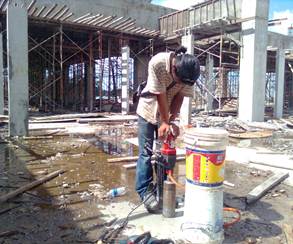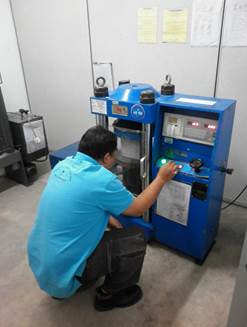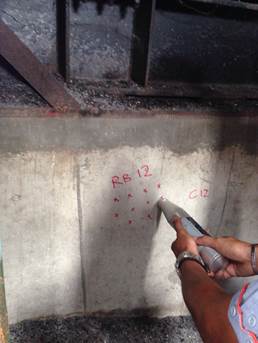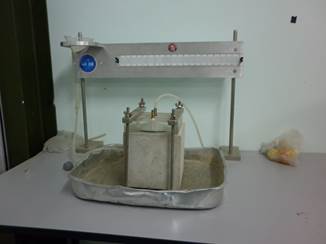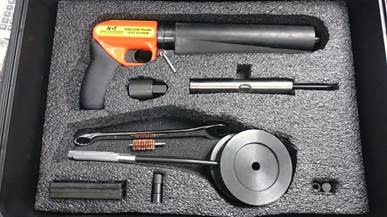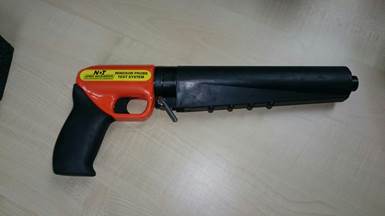Soil, Foundation, Geotechnical and Geological Specialist.......
|
|
|
|
Concrete Testing
a) Concrete Coring Test (BS 1881 : Part 120 : 1983)
b) Slump Test (BS 1881 : Part 102 : 1983) c) Concrete Cube Test (BS 1881 : Part 116 : 1983) d) Rebound Hammer Test (BS 1881 : Part 202 : 1986) e) Aggregate Testing for Concreting (MS 30 : 1995) f) Water Testing for Concreting (MS 28 : 1985) g) Initial Surface Absorption Test (BS 1881 : part 208 : 1996) h) Windsor Probe Test (ASTM C - 803) i) Potential Alkali Reactivity of Aggregate (ASTM C 1260-07)
(a) CONCRETE CORING TEST
Condition of concrete in the structure after construction can be assessed directly by core drilling at required location
or at suspected location. The core samples obtained are then taken for visual inspection and compression test to
determine maximum compressive strength.
(b) SLUMP TEST
The concrete slump test is used for the measurement of a property of fresh concrete. The test is an empirical test that
measures the workability of fresh concrete.
(c) CONCRETE CUBE TEST
In concrete compression test, normally 150 mm x 150 mm x 150 mm concrete cube
samples is used for testing. Test procedures require specimens are cast in a
number of standard sizes convenient for compressive and flexural strength determination.
(d) REBOUND HAMMER TEST
The rebound hammer test is widely known as Schmidt Hammer Test. It is one of the most commonly used non-destructive tests for hardened concrete. The concept of this method is to correlate the surface hardness of the concrete surface to the compressive strength of the concrete.
(e) AGGREGATE TESTING FOR CONCRETING
Samples of the coarse and fine aggregate shall be tested in accordance with MS 30 and other standards as specified in
Table 9.3 (JKR/SPJ/1988) to ensure their suitability of the aggregate for making the concrete. This tests include Grading
(MS 30), Elongation Index (MS 30), Flakiness Index (MS 30), Water Absorption Test (MS 30), Clay, Silt, Dust Content (MS 30),
Organic Impurities (MS 30), Aggregate Crushing Value (MS 30), Soundness Test (ASTM C88), Chloride Content (BS 812:Part 4) and
Sulphate Content (BS 1377:Test 9).
(f) WATER TESTING FOR CONCRETING
All water for making the concrete shall comply with the requirement of MS 28. This is to ensure the water clean and free from harmful matter.
(g) INITIAL SURFACE ABSORPTION TEST (BS 1881 part 208 : 1996)
The ISAT was originally developed as a laboratory method of measuring the porosity of concrete. Where carried out on oven dried concrete, the results are reasonably influenced by the existing moisture conditions as well as surface cleanliness. The test consists of the measurement of water flow into the test specimen through a known surface area. The contact area is defined by a plastic cell sealed onto the surface. Measurement of the volume flow is obtained by measurement of the length of flow along a capillary of known dimension. The method may also be used to determine the water absorption of concrete cast into prisms or cylinders where the surface to volume ratio can be calculated and where no point in the specimen is more than 50 mm from a free surface. The measured water absorption of the specimen is corrected to that equivalent to a surface to volume ratio of a core 75 mm long with a diameter of 75 mm.
(h) WINDSOR PROBE TEST
The Windsor probe uses a powder-activated driver to fire a hardened-alloy probe into the concrete. The exposed length of the probe is a measure of the penetration resistance of concrete. The standard test procedure is described in ASTM C-803. The type and amount of aggregate play an important role in the penetration resistance, which becomes critical when determining the relationship between penetration resistance and strength. Due to the small volume under testing, the variation in the Windsor probe-test results is higher (as is the case in determining surface hardness) when compared with the variation in standard compressive strength tests on companion specimens. But this method is excellent for measuring the relative rate of strength development of concrete at early ages, especially for determining stripping time for formwork.
(i) Potential Alkali Reactivity of Aggregates (Mortar Bar Method) ASTM C 1260-07
Potential Alkali Reactivity of Aggregate provides a means of detecting the potential of an aggregate intended for use in concrete for undergoing alkali-silica reaction resulting in potentially deleterious internal expansion. It is especially useful for aggregates that react slowly or produce expansion late in the reaction. However, it does not evaluate combinations of aggregates with cementitious materials nor are the test conditions representative of those encountered by concrete in service. 4.2 Because the specimens are exposed to a NaOH solution, the alkali content of the cement is not a significant factor in affecting expansions.
|


